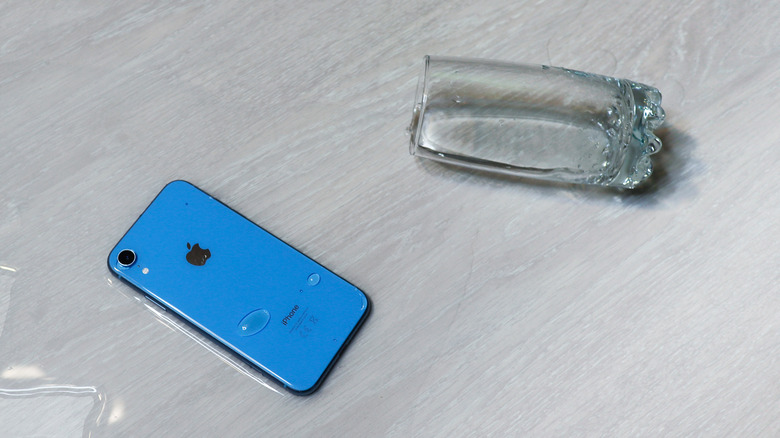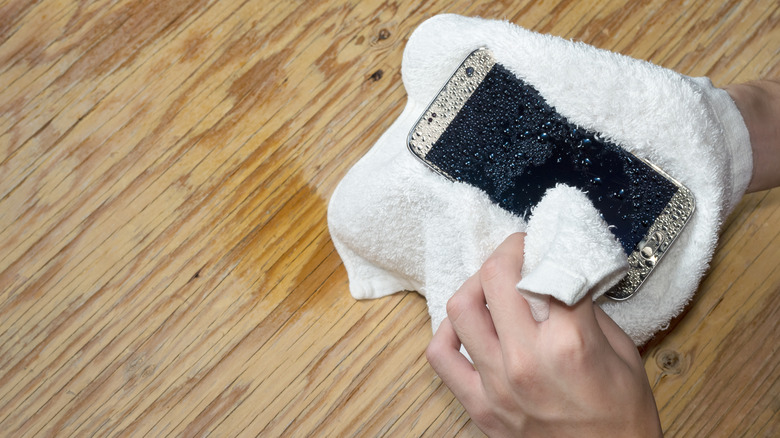What You Need To Do If Your Phone Gets Water Damaged
Most of us know enough about smartphone care to keep our phones away from water. That being said, accidents happen, and chances are that you'll get water in your phone at some point. It might be a coffee (or tea) spill, rain water, or more commonly, an unfortunate dunk in the toilet bowl. The good news is, water damage to your smartphone isn't irreparable. You can bring your phone back to life if you act fast and take the right steps.
If you have a water-resistant phone, it might surprise you that it can still be damaged by water or spills. Most people misinterpret "water-resistant" as "waterproof," and that can be a costly mistake. Yes, water-resistant phones are designed to withstand a certain degree of liquid contact, but they aren't completely waterproof. It might be okay to take your phone for a swim, but even the most "water-resistant" phones can only withstand a certain amount of water exposure for a given amount of time before they begin to malfunction and possibly sustain damage.
All smartphones can get water-damaged, whether they're water-resistant or not, but we'll discuss what you can do to salvage your dripping device from downright destruction. First, let's address a common myth:
Can rice save a wet phone?
A common DIY tidbit of advice you'll likely get when your phone gets wet is to turn it off and dunk it in some rice. It's so popular, it has become a meme — but what's important is, does it work? Can rice actually save your wet phone from permanent damage? Short answer: Yes, rice can rescue your wet phone from sudden death. But it's not your most effective solution.
Rice is absorbent. So if you bury your phone in a pack of Uncle Ben's, it will absorb moisture alright. But rice cannot remove all the moisture hidden deep within your phone, and even a small amount of water is enough to corrode and damage your phone's electric components. Also, since rice is starchy, it gets sticky as it absorbs moisture. The resulting paste could sneak into your headphone jack, charging docks, and other ports and cause further damage.
USA Today conducted an experiment to test how effective rice is in drying wet phones, and they found that rice was even slower at drying a phone than just leaving it out to dry, although they did clarify that neither worked fast enough. Only 13% of the water came out of the phone after about 48 hours in rice, and that's more than enough time for liquid to wreak permanent damage on a phone.
Knowing rice isn't the best option for saving your phone, here's what you should do instead.
Turn it off instantly (and leave it off!)
What kills a wet phone is electricity. Water and electricity do not go together, as you might already know if you've ever touched a socket with a wet hand. Phones are obviously powered by electricity, so if you leave a wet phone on, that electricity will flow and react with the water that's inside, and your phone's circuit board will get fried.
The first thing you need to do to your wet phone is turn it off ASAP (after retrieving it from the liquid, of course). Don't turn it back on until it's completely dried out. Heads up, this could mean leaving it off for up to 48 hours. That's terrible news if you're always on your phone, we understand, but here's a list of 202 things you could do instead of spending time on your phone. The next step is to try and get out as much liquid as you can, and there are a few ways you shouldn't do that.
Get as much water out as you can
Although it might seem like a good idea to use a blow dryer on your wet phone, it might be more harmful than helpful. The current could drive moisture farther into your phone, and the heat will only cause more damage to the delicate components of your device. This is also why it's a bad idea to leave a wet phone out in the sun to dry.
Instead, gently shake your phone to force water out of all the ports, then wipe it down with a dry microfiber cloth. After that, take it apart and remove as many components as you can. Of course, we're not suggesting you pull out your precision screwdrivers and dismantle your phone — that might complicate the damage and also void your warranty. Remove everything you possibly can — protective case, SIM card, SD card, and battery (if removable). Wipe those down as well and leave them in a cool place to dry.
You could place your phone near a window, fan, or AC vent to speed up the drying process. Another option is to bury your phone in an airtight container with desiccant packets. Desiccant packets (also known as Silica gels) are those little bags you find in shoe boxes with the "DO NOT EAT" warning on them. They absorb water better than rice does, so they can help wick more moisture from your phone.
After your phone has dried, put it back together and try turning it on. If it works, great! You should still keep an eye on it for a few weeks to be sure that everything works as it should. If you notice any malfunction, take your phone to an expert to get a repair or replacement.



